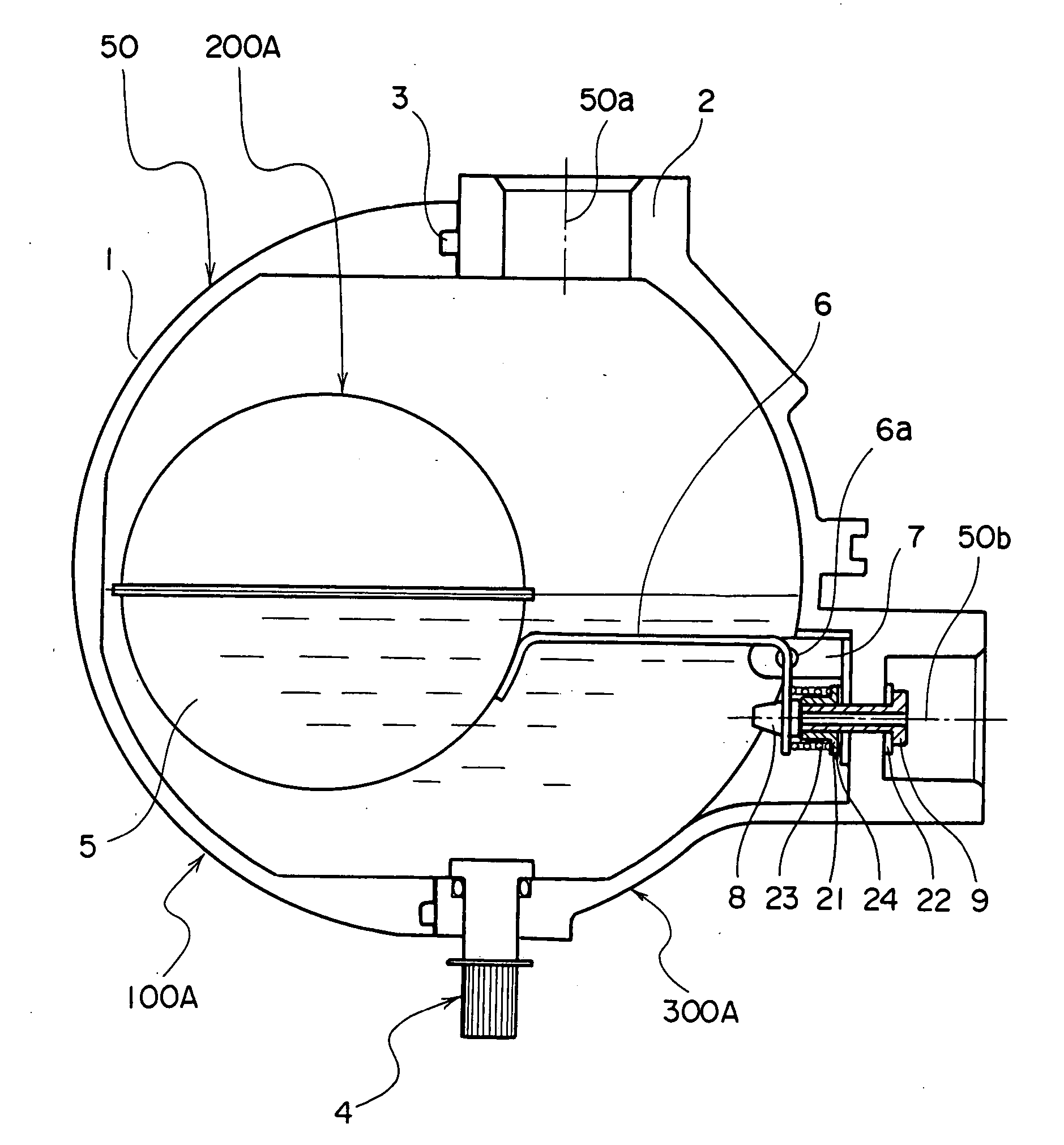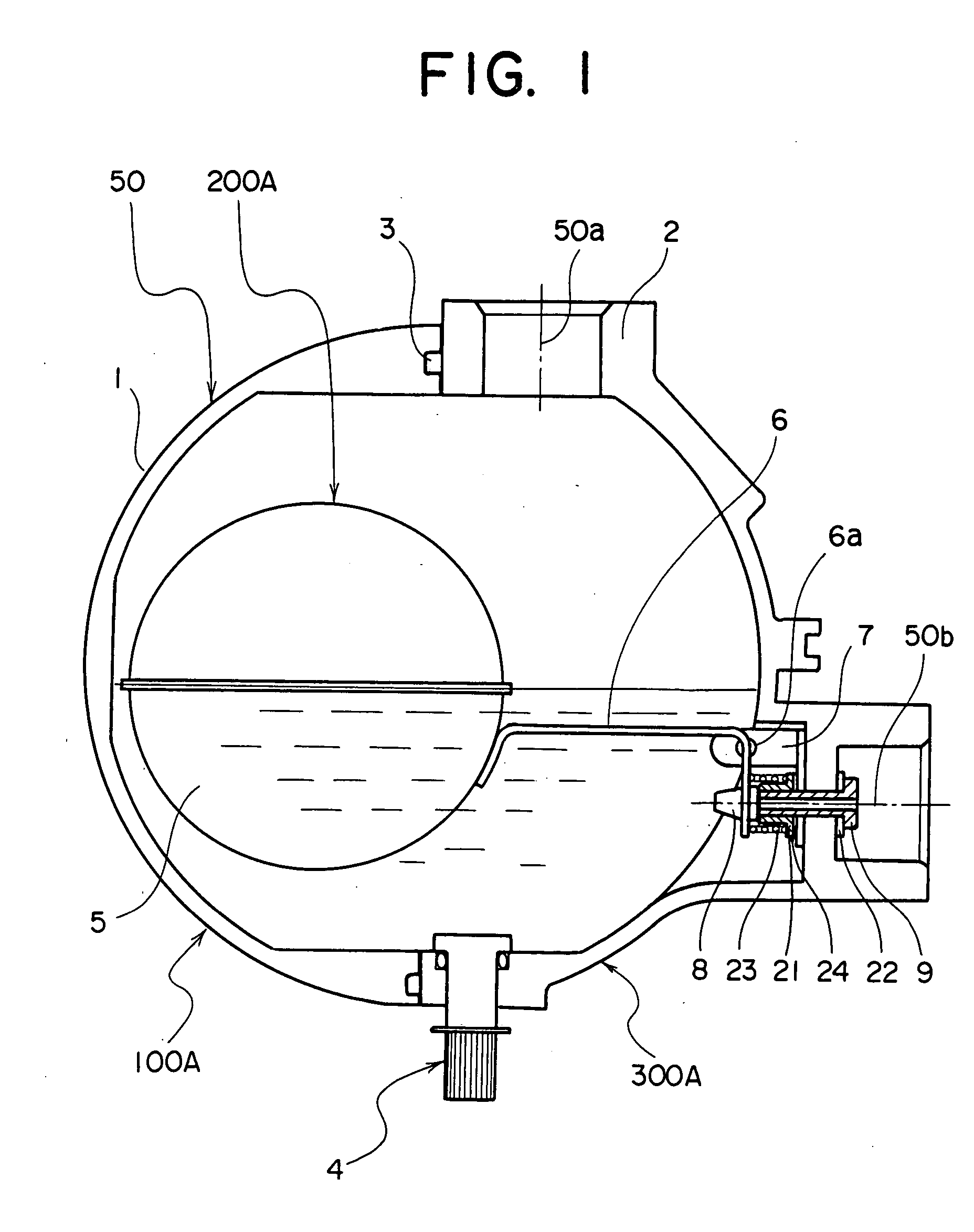Buoyancy type drain trap
a drain trap and buoyancy technology, applied in the direction of valve details, thin material handling, valve arrangement, etc., can solve the problems of difficult uncertain opening and closing of the valve seat, and difficulty in opening and closing the valve seat, so as to improve the buoyancy, reduce the weight of the float, and discharge the drain water smoothly
- Summary
- Abstract
- Description
- Claims
- Application Information
AI Technical Summary
Benefits of technology
Problems solved by technology
Method used
Image
Examples
first embodiment
[0030] As shown in FIGS. 1, 2, 3, 4, and 7, reference symbol 300A indicates a drain trap which is composed of a case 10A, a float 200A, and a coil spring 23 serving as an auxiliary buoyancy device situated between the case 100A and the float 200A.
[0031] The case 100A is integrally formed by a case main body 50, a float bracket 7, a valve 9, an adjustment screw 21, an adjustment washer 24, a packing 22, and manual valve 4 equipped with an O-ring.
[0032] As shown in detail in FIG. 4, the valve 9 in this example is equipped with a flange, and the flange side of the valve 9 is situated on the outer side of the case main body 50 with the packing 22 therebetween. Further, the valve 9 is connected to the case main body 50 through thread engagement, and the other end thereof on the opposite side of the flange, that is, a screw portion protrudes into the case main body 50. The protruding portion has the adjustment screw 21 equipped with a flange, the flange side of the adjustment screw 21 b...
second embodiment
[0051] Referring to FIGS. 5 and 7, reference symbol 300B indicates a drain trap which is composed of a case 100B, a float 200A, and a compression spring 25 situated between the case 100B and the float 200A and serving as an auxiliary buoyancy device 25.
[0052] In this case, the case 100B is the same as that of the conventional technique as shown in FIG. 8, and the float 200A is the same as that of the first embodiment as shown in FIG. 1, so description thereof will be omitted.
[0053] Thus, the second embodiment differs from the first embodiment in that the compression spring 25 serving as the auxiliary buoyancy device is situated between the case main body 50 constituting the case 100B and the float main body 5 constituting the float 200A. Regarding the compression spring 25, one end thereof may be fixed to the case main body 50 with the other end thereof not being fixed to the float main body 5, so that when the float main body 5 rises due to the buoyancy F, the compression spring ...
third embodiment
[0065] Referring to FIGS. 6 and 7, reference symbol 300C indicates a drain trap which is composed of a case 100C, a float 200B, and a compression spring 23 situated between the case 100C and the float 200B and serving as an auxiliary buoyancy device.
[0066] In this case, regarding the case 100C, as shown in FIG. 6, instead of the manual valve 4 of the case 100A of the first embodiment of FIG. 1, there are provided a stay 16, a washer 18, a nut 19, a plate spring bracket 15, a fixation screw 17, and a plate spring 14; regarding the float 200B, instead of the arm 6 of the float 200A of the first embodiment equipped with the rotation shafts 6a, there is formed an arm 20 equipped with rotation shafts 20a; and further, there are added an adjustment screw 10, a nut 11, a magnet seat 12, and a magnet 13.
[0067] Thus, the third embodiment differs from the first embodiment in that, in addition to the force of FIG. 1, there is to be expected an suction force due to the magnet 13 and the plate...
PUM
 Login to View More
Login to View More Abstract
Description
Claims
Application Information
 Login to View More
Login to View More - R&D
- Intellectual Property
- Life Sciences
- Materials
- Tech Scout
- Unparalleled Data Quality
- Higher Quality Content
- 60% Fewer Hallucinations
Browse by: Latest US Patents, China's latest patents, Technical Efficacy Thesaurus, Application Domain, Technology Topic, Popular Technical Reports.
© 2025 PatSnap. All rights reserved.Legal|Privacy policy|Modern Slavery Act Transparency Statement|Sitemap|About US| Contact US: help@patsnap.com



